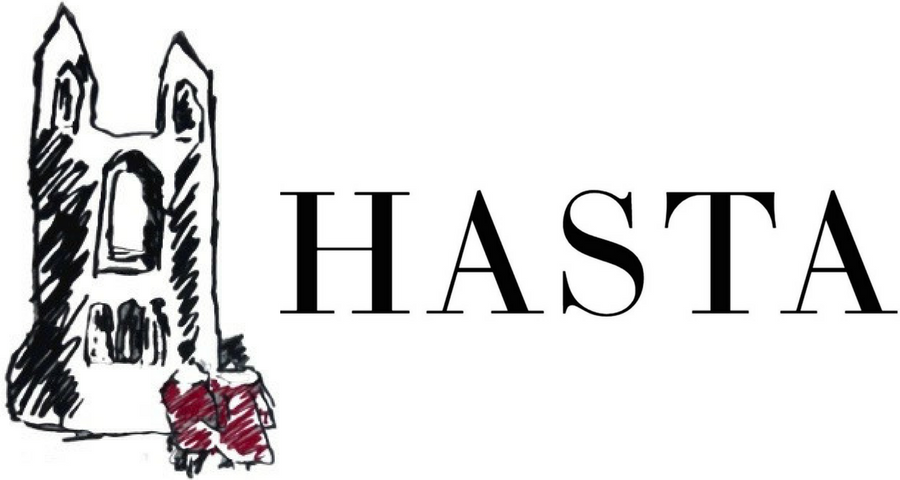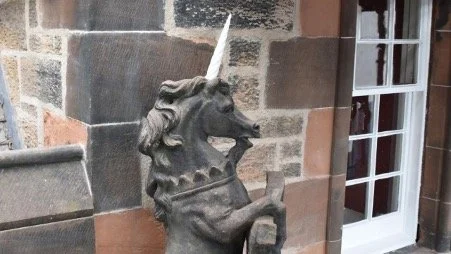Faith as Valour: The Magic of Scotland's National Animal
By Megan Waugh
There is one particular creature whose distinct horn appears to permeate our wider consciousness at every turn. The unicorn has long served as a powerful symbol; beloved throughout thousands of years of belief in its corporeality and its endurance afterward as an eminent figure of ‘fantasy’. Fact or fiction, it pervades our reality nonetheless — whether it is leaping up to the lion on our passports or greeting us at the mouths of historic buildings — its eminence as Scotland’s national animal is clear. When William the First inscribed its image into the Royal Coat of Arms, it was for the valour of its sharp horn; but I do not think that he realised that its greatest strength would manifest through other means. Its horn serves not as a weapon of violence but as a beacon of inspiration.
Martin Schongauer, Altarpiece of the Dominicans: The Mystical Hunt, c. 1470-80, Oil on panel, 115 x 115 cm, Musée Unterlinden, Colmar, France. Image courtesy of Fine Art America.
We see evidence of the unicorn’s impact across all of Scotland. Spanning representations modest and ornate, it can be found in the mercat crosses at the hearts of towns and cities, or dwelling at buildings entrances such as that of Stirling Castle, assuming its heraldic, protective position as it welcomes guests into the historic landmark. At Charles III’s coronation, it glimmered atop a nineteenth-century wand to anoint the new ruler. Amidst the old and the new, it has formed a phantasmagoria of symbolic significance. As Mike MacEachran states: ‘In most countries, the national animal is little more than a consequence of natural history or geography.’ So why does the mythological being endure?
The Unicorn in Captivity (from The Unicorn Tapestries), c. 1495-1505, tapestry, 368 x 251.5 cm, The Metropolitan Museum of Art, New York. Image courtesy of The Metropolitan Museum of New York..
In tracing its chains, we can find Scotland’s strong linkage to the unicorn as being rooted in Celtic tradition. People upheld the creature for its symbolism of both innocence and purity as well as chivalry and pride. Also at the core of their values was a belief in the ‘otherworlds’: an interactive cosmology imbued with spiritual energies and significance. This manifestation of divinity created a heightened intimacy with the physical world for the Celts as it was imagined not as a separate, supernatural realm; but as an overlaid landscape, making magic feel more tangible for all. Furthermore, their perception of goodness was aligned with an acknowledgment of the unseen: that there is strength and honour in an awareness of magical entities, even if they are not immediately visible.
Today, we may have lost some of the confidence with which the Celtic tradition regarded systems of faith, but still this creature of magic continues to spear our attention. Even where it is not visible, its presence is inferred. The Dennistoun Memorial in Greyfriars’ Kirkyard heralds a horse head at its peak. There has been frequent speculation as to whether there has been damage done to the monument. Why? Because the horse is missing a horn. The assumption is that the magical creature would be the most distinguished way to honour a gravesite, so much so that the ‘real’ creature appears disfigured. Recently, a pair of nineteenth-century unicorn sculptures at the top of Edinburgh’s Royal Mile underwent a restoration project. Their original horns, made of wood and lead, had previously been missing, but efforts were made to restore the sculptures to their true image.
Ross Morris and Robert Wilson, Unicorn Figure at The Scotch Whisky Experience, 1887 and 2025, Edinburgh. Image courtesy of The Scotch Whisky Experience.
The unicorn challenges the restrictive nature of ‘reality’, urging us to not limit our perceptions of what is ‘real’. Though its existence has never been proven, it has continuously manifested itself in our culture in a way that is evidence, nonetheless. Perhaps it is not corporeal; not flesh and bone; but it is valued still. Its enchantment is testament to people’s attachment to ideas that transcend our physical realm, that we may be in the constant presence of magic. A keen navigator between the realms of myth and reality, the unicorn anchors our search for faith.
Bibliography
Hatton, Mark. ‘Unicorn?’ Friends of Greyfriars Kirkyard. 2025. https://fogk.org/2025/05/04/unicorn/.
MacEacheran, Mike. ‘What unicorns mean to Scottish identity’. BBC Travel. 2019. https://www.bbc.co.uk/travel/article/20190408-what-unicorns-mean-to-scottish-identity
Pooran, Neil. ‘Unicorn sculptures on Royal Mile to have missing horns restored’. The Scotsman. 2025. https://www.scotsman.com/heritage-and-retro/heritage/unicorn-sculptures-on-royal-mile-to-have-missing-horns-restored-5013460
Walker, Adam. ‘The Literary and Theological Otherworlds in MacDonald’s Fairy Tales.’ Journal of Scottish Thought 12, no. 1, (2020): 108-125.



